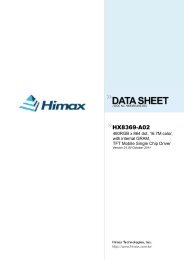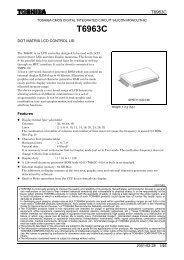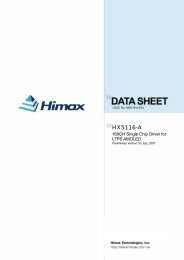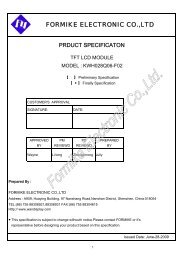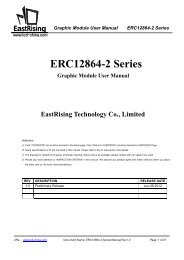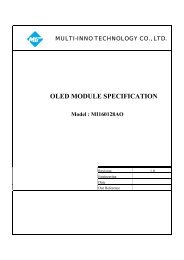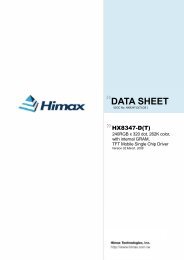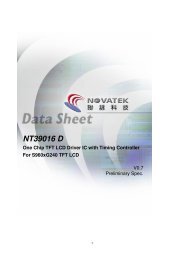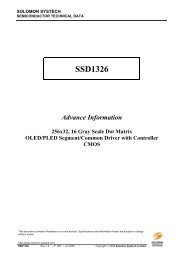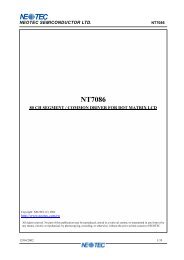MI0283ST - Display Future
MI0283ST - Display Future
MI0283ST - Display Future
You also want an ePaper? Increase the reach of your titles
YUMPU automatically turns print PDFs into web optimized ePapers that Google loves.
MULTI-INNO TECHNOLOGY CO., LTD.LCD MODULE SPECIFICATIONModel : <strong>MI0283ST</strong>Revision 1.1EngineeringDateOur ReferenceAddress : Room 10J,Xin HaoFang Building, No.188 Shennan Road,Nanshan Drstrict, ShenZhen,China.Tel : (86-755)2643 9937Fax : (86-755)8613 4241Email : sales@multi-inno.comWeb : http://www.multi-inno.com
MODULE NO.: <strong>MI0283ST</strong> Ver 1.1REVISION RECORDREV NO. REV DATE CONTENTS REMARKS0.1 2009-7-18 First release1.0 2009-9-7 Full spec1.1 2011-07-15Reflectivity and surface brightness value changeMULTI-INNO TECHNOLOGY CO.,LTD.P.2
MODULE NO.: <strong>MI0283ST</strong> Ver 1.1CONTENTSGENERAL INFORMATIONEXTERNAL DIMENSIONSABSOLUTE MAXIMUM RATINGSELECTRICAL CHARACTERISTICSELECTRO-OPTICAL CHARACTERISTICS INTERFACE DESCRIPTION APPLICATION CIRCUIT INITIAL CODERELIABILITY TESTINSPECTION CRITERIONPRECAUTIONS FOR USING LCD MODULESUSING LCD MODULESPRIOR CONSULT MATTERMULTI-INNO TECHNOLOGY CO.,LTD.P.3
MODULE NO.: <strong>MI0283ST</strong>Ver 1.1 GENERAL INFORMATIONItem Contents UnitLCD type TFT/TRANSFLECTIVE /Viewing direction 12:00 O’ Clock O’ClockModule area (W × H) 50.00×69.20×2.85 mm 2Viewing area (W×H) 47.00×60.10 mm 2Active area (W×H) 43.20×57.60 mm 2Number of Dots 240(RGB)×320 /Pixel pitch (W × H) 0.18×0.18 mm 2Driver IC R61505W /Interface Type System parallel interface/SPI+RGB /Input voltage 2.8 VModule Power consumption 246 mwColors 262K /Backlight Type LED / EXTERNAL DIMENSIONS环 保 标 准12:00MULTI-INNO TECHNOLOGY CO.,LTD.P.4
MODULE NO.: <strong>MI0283ST</strong>Ver 1.1ABSOLUTE MAXIMUM RATINGSParameter Symbol Min Max UnitSupply voltage for logic VCC/VCI/IOVCC -0.3 4.6 VInput voltage VIN -0.3 IOVCC+0.3 VOperating temperature Top -20 70 °CStorage temperature TST -30 80 °CHumidity RH - 90%(Max60 °C) RHELECTRICAL CHARACTERISTICSDC CHARACTERISTICSParameter Symbol Min Typ Max UnitSupply voltage for logic VCC/VCI 2.5 2.8 3.3 VI/O power supply IOVCC 1.65 1.8/2.8 3.3 VInput Current Idd - 9.72 19.44 mAInput voltage 'H' level VIH 0.8IOVCC - IOVCC VInput voltage 'L' level VIL -0.3 - 0.2IOVCC VOutput voltage 'H' level VOH 0.8IOVCC - - VOutput voltage 'L' level VOL - - 0.2IOVCC V TIMING OF POWER SUPPLYPLEASE REFER TO THE DRIVER IC SPECIFICATION. BACKLIGHT CHARACTERISTICSItem Symbol Min. Typ. Max. Unit ConditionForward voltage Vf 2.9 3.2 3.4 VIf=60mALuminance Lv 3500 4000 4500 cd/m 2 Ta=25℃Number of LED - - 4 - Piece -Connection mode P - Parallel - - -Using condition: constant current driving method If=60mA(+/-10%).MULTI-INNO TECHNOLOGY CO.,LTD.P.5
MODULE NO.: <strong>MI0283ST</strong>Ver 1.1ELECTRO-OPTICAL CHARACTERISTICSItem Symbol Condition Min Typ Max Unit Remark NoteResponse time Tr+ Tf - 32.8 49.2 ms Fig.1 4Contrast ratio Cr 47 95 - --- FIG 2. 1θ=0°Luminanceδ WHITE ∅=0°81 90 - % FIG 2. 3uniformityTa=25℃SurfaceLv99 124 - cd/m 2 FIG 2. 2LuminanceReflectivity R - - 3.5755 - - - -∅ = 90° 31 41 - deg FIG 3.Viewing angle∅ = 270° 22 32 - deg FIG 3.θrange∅ = 0° 35 45 - deg FIG 3.6∅ = 180° 35 45 - deg FIG 3.Red x 0.5149 0.5649 0.6149Red y 0.2967 0.3467 0.3967Green x 0.2920 0.3420 0.3920θ=0°CIE (x, y) Green y 0.5057 0.5557 0.6057∅=0°chromaticity Blue x 0.1031 0.1531 0.2031Ta=25℃Blue y 0.0610 0.1110 0.1610- FIG 2. 5White x 0.2473 0.3073 0.3673White y0.2635 0.3235 0.3835Note 1. Contrast Ratio(CR) is defined mathematically as For more information see FIG 2.:Contrast Ratio =Average Surface Luminance with all white pixels (P 1,P 2 , P 3,P 4, P 5 )Average Surface Luminance with all black pixels (P 1 , P 2 , P 3,P 4, P 5 )Note 2. Surface luminance is the LCD surface from the surface with all pixels displaying white. For moreinformation see FIG 2.Lv = Average Surface Luminance with all white pixels (P 1 , P 2 , P 3,P 4, P 5 )Note 3. The uniformity in surface luminance , δ WHITE is determined by measuring luminance at each test position 1through 5, and then dividing the maximum luminance of 5 points luminance by minimum luminance of 5 pointsluminance. For more information see FIG 2.Minimum Surface Luminance with all white pixels (P 1 , P 2 , P 3,P 4, P 5 )δ WHITE =Maximum Surface Luminance with all white pixels (P 1 , P 2 , P 3,P 4, P 5 )Note 4. Response time is the time required for the display to transition from White to black(Rise Time, Tr) and fromblack to white(Decay Time, Tf). For additional information see FIG 1. The test equipment is Autronic-Melchers’sConoScope. SeriesNote 5. CIE (x, y) chromaticity,The x,y value is determined by measuring luminance at each test position 1 through5,and then make average valueNote 6. Viewing angle is the angle at which the contrast ratio is greater than 2. For TFT module the conrast ratio isgreater than 10. The angles are determined for the horizontal or x axis and the vertical or y axis with respect to the zaxis which is normal to the LCD surface. For more information see FIG 3.Note 7. For Viewing angle and response time testing, the testing data is base on Autronic-Melchers’s ConoScope. SeriesInstruments. For contrast ratio, Surface Luminance, Luminance uniformity,CIE The test data is base on TOPCON’sBM-5 photo detector.Note 8. For Transflective or Reflective mode, Reflectivity should be tested. The test data is base on DMS-803. Formore information see FIG 4.MULTI-INNO TECHNOLOGY CO.,LTD.P.6
MODULE NO.: <strong>MI0283ST</strong> Ver 1.1FIG.1. The definition of Response TimeFIG.2. Measuring method for Contrast ratio,surface luminance, Luminance uniformity CIE (x, y) chromaticityA:5mmB: 5mmH,V : Active AreaLightspotsize∅=5mm, 500mm distance from theLCD surface to detector lensmeasurement instrument is TOPCON’s luminancemeter BM-5FIG.3. The definition of viewing angleMULTI-INNO TECHNOLOGY CO.,LTD.P.7
MODULE NO.: <strong>MI0283ST</strong> Ver 1.1FIG.4. Measuring method for optical characteristics in Transflective or Reflective modeDevice:Autroic-Melchers DMS-803Light source: DMS hemisphereDetector angle :θ= 0Detector position:Screen centerSpectrometer evaluation light source:D65 INTERFACE DESCRIPTIONInterfaceNO.Symbol1 IM02 IM13 IM24 IM3I/O orconnecttoIDescriptionSelect a mode to interface to host processor.(Amplitude: IOVCC ~GND),Refer TO NOTE1when not inuse5 RESET I Reset signal, low active -6 VSYNC I Frame synchronizing signal. IOVCC7 HSYNC I Frame synchronizing signal. IOVCC8 DOTCLK I Dot clock signal. GND9 ENABLE I10 DB1711 DB1612 DB1513 DB1414 DB1315 DB1216 DB1117 DB1018 DB919 DB820 DB721 DB622 DB523 DB424 DB325 DB2I/OMULTI-INNO TECHNOLOGY CO.,LTD.Data enable signal for RGB interface operation.(Amplitude: IOVCC-GND).Low: accessible (select)High: Not accessible (Not select)The polarity of ENABLE signal can be inverted bysetting the EPL bit.(Amplitude: IOVCC-GND).18-bit parallel bi-directional data bus for 80-systeminterface operation(Amplitude: IOVCC-GND).8-bit I/F: DB[17:10] are used.9-bit I/F: DB[17:9] are used.16-bit I/F: DB[17:10] and DB[8:1] are used.18-bit I/F: DB[17:0] are used.18-bit parallel bi-directional data bus for RGBinterface operation(Amplitude: IOVCC-GND).16-bit I/F: DB[17:13] and DB[11:1] are used.18-bit I/F: DB[17:0] are used.----GND/IOVCCGND/IOVCCP.8
MODULE NO.: <strong>MI0283ST</strong> Ver 1.126 DB127 DB028 SDO O29 SDI I30 RD I31 WR/SCL I32 RS I33 CS I34 FMARK OSerial data output (SDO) pin in serial interfaceoperation. The data is outputted on the falling edgeof the SCL signal.Amplitude: IOVCC-GNDSerial data input (SDI) pin in serial interfaceoperation. The data is inputted on the rising edge ofthe SCL signal. Amplitude: IOVCCGNDRead strobe signal in 80-system bus interfaceoperation and enables read operation when RDX islow. Amplitude: IOVCC-GNDWrite strobe signal in 80-system bus interfaceoperationandenableswriteoperationwhenWRXislow. Synchronous clock signal (SCL) in serialinterface operation. Amplitude: IOVCC-GNDRegister select signal. Amplitude: IOVCC-GNDLow: select Index registerHigh: select control registerChip select signal. Amplitude: IOVCC-GNDLow: the R61505W is selected and accessibleHigh: the R61505W is not selected and notaccessibleFrame head pulse signal, which is used whenwriting data to the internal frame memory.(Amplitude: IOVCC-GND).OPENGND/IOVCCIOVCCIOVCCIOVCCIOVCC35 IOVCC - Interface voltage.1.65V~3.3V -36 VCC - Logic regulator power supply.2.5V~3.3V -37 VCI Iliquid crystal drive power supplyvoltage.2.5V~3.3V-38 GND - POWER GROUND -39 Y(u) NC NO CONNECT -40 X(L) NC NO CONNECT -41 Y(D) NC NO CONNECT -42 X(R) NC NO CONNECT -43 LEDA LED driver LED ANODE -44 LEDK1 LED driver LED CATHODE -45 LEDK2 LED driver LED CATHODE -46 LEDK3 LED driver LED CATHODE -47 LEDK4 LED driver LED CATHODE - APPLICATION CIRCUITPlease consult our technical department for detail information. INITIAL CODEPlease consult our technical department for detail information.OPENMULTI-INNO TECHNOLOGY CO.,LTD.P.9
MODULE NO.: <strong>MI0283ST</strong> Ver 1.1 RELIABILITY TESTNo. Test Item Test Condition1HighTemperatureStorage80±2/200 hours2Low TemperatureStorage-30±2/200 hours3High TemperatureOperating70±2/120 hours4Low TemperatureOperating-20±2/120 hours5 Temperature Cycle-20±2~25~70±2×10cycles(30min.) (5min.) (30min.)6 Damp ProofTest 50±5×90%RH/120 hours7 VibrationTestFrequency10Hz~55Hz~10HzAmplitude1.5mm,XYZ direction for total 3hours(Packing condition)8 Dropping testDrop to the ground from 1m height, one time, everyside of carton.(Packing condition)9 ESDtestVoltage:±8KV R: 330Ω C: 150pFAir discharge, 10timeRemark:1.The test samples should be applied to only one test item.2.Sample size for each test item is 5~10pcs.3.For Damp Proof Test, Pure water(Resistance10MΩ) should be used.4.In case of malfunction defect caused by ESD damage, if it would be recovered to normalstate after resetting, it would be judge as a good part.Using ionizer(an antistatic blower) is recommended at working area in order to reduceelectro-static voltage.When removing protection film from LCM panel, peel off the tag slowly( recommendedmore than one second) while blowing with ionizer toward the peeling face to minimize ESDwhich may damage electrical circuit.5.EL evaluation should be excepted from reliability test with humidity and temperature: Somedefects such as black spot/blemish can happen by natural chemical reaction with humidity andFluorescence EL has.6.Please use automatic switch menu(or roll menu) testing mode when test operating modeInspectionafter testInspection after2~4hours storageatroom temperature,thesample shall befreefrom defects:1.Air bubble in theLCD;2.Sealleak;3.Non-display;4.missingsegments;5.Glass crack;6.Current Idd istwicehigher than initialvalue.MULTI-INNO TECHNOLOGY CO.,LTD.P.10
MODULE NO.: <strong>MI0283ST</strong> Ver 1.1 INSPECTION CRITERIONOUTGOING QUALITY STANDARD PAGE 1 OF 4TITLE:FUNCTIONAL TEST & INSPECTION CRITERIAThis specification is made to be used as the standard acceptance/rejection criteria for Color mobilephone LCM.1SampleplanSampling plan according to GB/T2828.1-2003/ISO 2859-11999 and ANSI/ASQC Z1.4-1993,normal level 2 and based on:Major defect: AQL 0.65Minor defect: AQL 1.52. Inspection conditionViewing distance for cosmetic inspection is about 30cm with bare eyes, and under anenvironment of 20~40W light intensity, all directions for inspecting the sample should be within45against perpendicular line.3. Definition of inspection zone in LCD.ABCZone A: character/Digit areaZone B: viewing area except Zone A (ZoneA+ZoneB=minimum Viewing area)Zone C: Outside viewing area (invisible area after assembly in customer’s product)Fig.1 Inspection zones in an LCD.Note: As a general rule, visual defects in Zone C are permissible, when it is no trouble forquality and assembly of customer’s product.MULTI-INNO TECHNOLOGY CO.,LTD.P.11
MODULE NO.: <strong>MI0283ST</strong> Ver 1.1OUTGOING QUALITY STANDARD PAGE 2 OF 4TITLE:FUNCTIONAL TEST & INSPECTION CRITERIA4. Inspection standards4.1 Major DefectItemNoItems to beinspected4.1.1 Allfunctionaldefects4.1.2 Missing Missing componentInspection Standard1) No display2) <strong>Display</strong> abnormally3) Missing verticalhorizontal segment4) Short circuit5) Back-light no lighting, flickering and abnormal lighting.Classificationof defectsMajor4.1.3OutlinedimensionOverall outline dimension beyond the drawing is not allowed.4.2 Cosmetic DefectItemNo4.2.1Items to beinspectedClearSpotsBlack andwhite SpotdefectPinhole,ForeignParticle,Dirt underpolarizerDim SpotsInspection StandardFor dark/white spot, sizeis definedas =12.( x + y)2Size(mm)0.15ZoneAcceptable QtyA B CIgnore0.150.2 30.20.25 10.25 0xyIgnoreClassificationof defectsMinorCircleshaped anddim edgeddefects2. ZoneAcceptable QtySize(mm)A B C0.2Ignore0.200.60 4Ignore0.600.80 20.801.0 11.0 0MinorMULTI-INNO TECHNOLOGY CO.,LTD.P.12
MODULE NO.: <strong>MI0283ST</strong> Ver 1.1OUTGOING QUALITY STANDARD PAGE 3 OF 4TITLE: FUNCTIONAL TEST & INSPECTION CRITERIA4.2. Cosmetic DefectItemNoItems to beinspectedInspection StandardClassificationof defectsSize(mm)Acceptable Qty4.2.2Line defectBlack line,White line,Foreignmaterialunderpolarizer,ZoneL(Length) W(Width) A B CIgnore W0.02 IgnoreL3.0 0.02W0.03 2L2.0 0.03W0.05 1IgnoreMinor0.05WDefine as spotdefectIf the Polarizer scratch can be seen after mobile phonecover assembling or in the operating condition, judge bythe line defect of 4.2.2.If the Polarizer scratch can be seen only in non-operatingcondition or some special angle, judge by the following.Size(mm)Acceptable Qty4.2.3PolarizerscratchL(Length)W(Width)ZoneA B CMinorIgnore W0.03 Ignore5.0L10.0 0.03W0.05 2L5.0 0.05W0.08 1Ignore0.08W 0Air bubbles between glass & polarizer2. ZoneAcceptable Qty4.2.4PolarizeAir bubbleSize(mm)A B C0.2Ignore0.200.30 2Ignore0.300.50 1Minor0.50 0MULTI-INNO TECHNOLOGY CO.,LTD.P.13
MODULE NO.: <strong>MI0283ST</strong> Ver 1.1OUTGOING QUALITY STANDARD PAGE 4 OF 4TITLE:FUNCTIONAL TEST & INSPECTION CRITERIA4.3. Cosmetic DefectItemNoItems to beinspectedInspection StandardClassification ofdefects(i) Chips on cornerMinorX Y Z2.0 S DisregardNotes: S=contact pad lengthChips on the corner of terminal shall not be allowed to extendinto the ITO pad or expose perimeter seal.(ii)Usual surface cracks4.3.5GlassdefectMinorX Y Z3.0
MODULE NO.: <strong>MI0283ST</strong> Ver 1.1PRECAUTIONS FOR USING LCD MODULESHanding Precautions1) The display panel is made of glass and polarizer. As glass is fragile. It tends to become or chipped duringhandling especially on the edges. Please avoid dropping or jarring. Do not subject it to a mechanical shock bydropping it or impact.2) If the display panel is damaged and the liquid crystal substance leaks out, be sure not to get any in your mouth.If the substance contacts your skin or clothes, wash it off using soap and water.3) Do not apply excessive force to the display surface or the adjoining areas since this may cause the color tone tovary. Do not touch the display with bare hands. This will stain the display area and degraded insulationbetween terminals (some cosmetics are determined to the polarizer).4) The polarizer covering the display surface of the LCD module is soft and easily scratched. Handle thispolarizer carefully. Do not touch, push or rub the exposed polarizers with anything harder than an HB pencillead (glass, tweezers, etc.). Do not put or attach anything on the display area to avoid leaving marks on.Condensation on the surface and contact with terminals due to cold will damage, stain or dirty the polarizer.After products are tested at low temperature they must be warmed up in a container before coming iscontacting with room temperature air.5) If the display surface becomes contaminated, breathe on the surface and gently wipe it with a soft dry cloth. Ifit is heavily contaminated, moisten cloth with one of the following solvents- Isopropyl alcohol- Ethyl alcoholDo not scrub hard to avoid damaging the display surface.6) Solvents other than those above-mentioned may damage the polarizer. Especially, do not use the following.-Water-Ketone- Aromatic solventsWipe off saliva or water drops immediately, contact with water over a long period of time may causedeformation or color fading. Avoid contacting oil and fats.7) Exercise care to minimize corrosion of the electrode. Corrosion of the electrodes is accelerated by waterdroplets, moisture condensation or a current flow in a high-humidity environment.8) Install the LCD Module by using the mounting holes. When mounting the LCD module make sure it is free oftwisting, warping and distortion. In particular, do not forcibly pull or bend the I/O cable or the backlight cable.9) Do not attempt to disassemble or process the LCD module.10) NC terminal should be open. Do not connect anything.11) If the logic circuit power is off, do not apply the input signals.12) Electro-Static Discharge ControlSince this module uses a CMOS LSI, the same careful attention should bepaid to electrostatic discharge as for an ordinary CMOS IC. To prevent destruction of the elements by staticelectricity, be careful to maintain an optimum work environment.- Before remove LCM from its packing case or incorporating it into a set, be sure the module and your bodyhave the same electric potential. Be sure to ground the body when handling the LCD modules.- Tools required for assembling, such as soldering irons, must be properly grounded. make certain the ACpower source for the soldering iron does not leak. When using an electric screwdriver to attach LCM, thescrewdriver should be of ground potentiality to minimize as much as possible any transmission ofelectromagnetic waves produced sparks coming from the commutator of the motor.- To reduce the amount of static electricity generated, do not conduct assembling and other work under dryconditions. To reduce the generation of static electricity be careful that the air in the work is not too dried. Arelative humidity of 50%-60% is recommended. As far as possible make the electric potential of your workclothes and that of the work bench the ground potential- The LCD module is coated with a film to protect the display surface. Exercise care when peeling off thisprotective film since static electricity may be generated13) Since LCM has been assembled and adjusted with a high degree of precision, avoid applying excessive shocksto the module or making any alterations or modifications to it.- Do not alter, modify or change the shape of the tab on the metal frame.- Do not make extra holes on the printed circuit board, modify its shape or change the positions ofcomponents to be attached.- Do not damage or modify the pattern writing on the printed circuit board.- Absolutely do not modify the zebra rubber strip (conductive rubber) or heat seal connector.- Except for soldering the interface, do not make any alterations or modifications with a soldering iron.- Do not drop, bend or twist LCM.MULTI-INNO TECHNOLOGY CO.,LTD.P.15
MODULE NO.: <strong>MI0283ST</strong> Ver 1.1Handling precaution for LCMLCM is easy to be damaged. Please note below and be careful for handling.Correct handling:As above picture, please handle with anti-static gloves around LCM edges.Incorrect handling:Please don’t touch IC directly.Please don’t stack LCM.Please don’t hold the surface of panel.Please don’t stretch interface of output, suchas FPC cable.Please don’t hold the surface of IC.Please don’t operate with sharp stick such aspens.MULTI-INNO TECHNOLOGY CO.,LTD.P.16
MODULE NO.: <strong>MI0283ST</strong> Ver 1.1Storage PrecautionsWhen storing the LCD modules, the following precaution is necessary.1) Store them in a sealed polyethylene bag. If properly sealed, there is no need for the dessicant.2) Store them in a dark place. Do not expose to sunlight or fluorescent light, keep the temperature between 0°Cand 35°C, and keep the relative humidity between 40%RH and 60%RH.3) The polarizer surface should not come in contact with any other objects. (We advise you to store them in theanti-static electricity container in which they were shipped.OthersLiquid crystals solidify under low temperature (below the storage temperature range) leading to defectiveorientation or the generation of air bubbles (black or white). Air bubbles may also be generated if the module is subjectto a low temperature.If the LCD modules have been operating for a long time showing the same display patterns, the display patternsmay remain on the screen as ghost images and a slight contrast irregularity may also appear. A normal operating statuscan be regained by suspending use for some time. It should be noted that this phenomenon does not adversely affectperformance reliability.To minimize the performance degradation of the LCD modules resulting from destruction caused by staticelectricity etc., exercise care to avoid holding the following sections when handling the modules.- Exposed area of the printed circuit board.-Terminal electrode sections.MULTI-INNO TECHNOLOGY CO.,LTD.P.17
MODULE NO.: <strong>MI0283ST</strong> Ver 1.1 USING LCD MODULESInstalling LCD ModulesThe hole in the printed circuit board is used to fix LCM as shown in the picture below. Attend to the following itemswhen installing the LCM.1) Cover the surface with a transparent protective plate to protect the polarizer and LC cell.2) When assembling the LCM into other equipment, the spacer to the bit between the LCM and thefitting plate should have enough height to avoid causing stress to the module surface, refer to theindividual specifications for measurements. The measurement tolerance should be ±0.1mm.Precaution for assemble the module with BTB connector:Please note the position of the male and female connector position, don’t assemble or assemble like the methodwhich the following picture showsMULTI-INNO TECHNOLOGY CO.,LTD.P.18
MODULE NO.: <strong>MI0283ST</strong>Ver 1.1Precaution for soldering the LCMNo RoHSproductRoHSproductManual soldering Machine drag soldering Machine press soldering290°C ~350°C. 330°C ~350°C.300°C ~330°C.Time : 3-5S. Speed : 4-8 mm/s.Time : 3-6S.340°C ~370°C.Time : 3-5S.350°C ~370°C.Time : 4-8 mm/s.Press: 0.8~1.2Mpa330°C ~360°C.Time : 3-6S.Press: 0.8~1.2Mpa1) If soldering flux is used, be sure to remove any remaining flux after finishing to soldering operation. (Thisdoes not apply in the case of a non-halogen type of flux.) It is recommended that you protect the LCD surfacewith a cover during soldering to prevent any damage due to flux spatters.2) When soldering the electroluminescent panel and PC board, the panel and board should not be detached morethan three times. This maximum number is determined by the temperature and time conditions mentionedabove, though there may be some variance depending on the temperature of the soldering iron.3) When remove the electroluminescent panel from the PC board, be sure the solder has completelymelted, the soldered pad on the PC board could be damaged.Precautions for Operation1) Viewing angle varies with the change of liquid crystal driving voltage (VLCD). Adjust VLCD to show the bestcontrast.2) It is an indispensable condition to drive LCD's within the specified voltage limit since the higher voltage thenthe limit cause the shorter LCD life. An electrochemical reaction due to direct current causes LCD'sundesirable deterioration, so that the use of direct current drive should be avoided.3) Response time will be extremely delayed at lower temperature than the operating temperature range and on theother hand at higher temperature LCD's show dark color in them. However those phenomena do not meanmalfunction or out of order with LCD's, Which will come back in the specified operating temperature.4) If the display area is pushed hard during operation, the display will become abnormal. However, it will returnto normal if it is turned off and then back on.5) A slight dew depositing on terminals is a cause for electro-chemical reaction resulting in terminal open circuit.Usage under the maximum operating temperature, 50%RH or less is required.6) Input logic voltage before apply analog high voltage such as LCD driving voltage when power on. Removeanalog high voltage before logic voltage when power off the module. Input each signal after thepositive/negative voltage becomes stable.7) Please keep the temperature within specified range for use and storage. Polarization degradation, bubblegeneration or polarizer peel-off may occur with high temperature and high humidity.Safety1) It is recommended to crush damaged or unnecessary LCDs into pieces and wash them off with solvents such asacetone and ethanol, which should later be burned.2) If any liquid leaks out of a damaged glass cell and comes in contact with the hands, wash off thoroughly withsoap and water.Limited WarrantyUnless agreed betweenMulti-Innoand customer, Multi-Inno will replace or repair any of its LCD modules whichare found to be functionally defective when inspected in accordance with Multi-Inno LCD acceptance standards(copies available upon request) for a period of one year from date of production. Cosmetic/visual defects must bereturned to Multi-Innowithin 90 days of shipment. Confirmation of such date shall be based on data code on product.The warranty liability of Multi-Inno limited to repair and/or replacement on the terms set forth above. Multi-Inno will notbe responsible for any subsequent or consequential events.Return LCM under warrantyNo warranty can be granted if the precautions stated above have been disregarded. The typical examples ofviolations are :- Broken LCD glass.- PCB eyelet is damaged or modified.- PCB conductors damaged.- Circuit modified in any way, including addition of components.- PCB tampered with by grinding, engraving or painting varnish.- Soldering to or modifying the bezel in any manner.Module repairs will be invoiced to the customer upon mutual agreement. Modules must be returned with sufficientMULTI-INNO TECHNOLOGY CO.,LTD.P.19
MODULE NO.: <strong>MI0283ST</strong>Ver 1.1description of the failures or defects. Any connectors or cable installed by the customer must be removed completelywithout damaging the PCB eyelet, conductors and terminals. PRIOR CONSULT MATTER1.For Multi-Inno standard products, we keep the right to change material, process ... for improvingthe product property without notice on our customer.For OEM products, if any change needed which may affect the product property, we will consult withour customer in advance.2. If you have special requirement about reliability condition, please let us know before you start the teston our samples.MULTI-INNO TECHNOLOGY CO.,LTD.P.20




